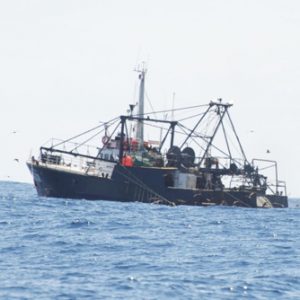The commercial fishing industry has recently taken a battering by an in-depth study of under reporting and wasteful dumping of fish in New Zealand waters over the last 60 years.
For Karl Warr, a commercial fisherman in Hawke’s Bay, this wasn’t a surprise – he has seen the issue throughout his 15-year commercial career.
But rather than simply accepting the indiscriminate waste that typically occurs with commercial trawling, Karl has been working to find a solution to the problem through exploring alternative designs for trawl nets.

His first attempt was a wooden box with holes at the end of the net so undersized fish had a chance at escaping instead of being crushed with the other fish balled up in a traditional trawl net. From the beginning, the box concept started producing results. After refinements funded from his own pocket, Karl moved onto a wire box. Overall, rates of undersized fish being caught in the net fell from as high as 50% down to 5%.
Recently, Karl has been experimenting with plastic piping. The piping is fitted over the net mesh to help keep the mesh open when trawling. The mesh Karl uses is a rectangular pattern; different from regular diamond shaped netting.
The rectangular shape helps to improve the fish’s chances of escape and provides more sorting power when used in conjunction with the box. The piping is cheap to make, provides a cost-effective option for fishers who cannot afford a box and also provides a quick patch fix for others in the industry.
So what differences do these innovations actually make? In the old days, a total catch of 100 tonnes of fish would be caught in the net. Now, about 20 tonnes of that total are undersize fish that escape to live and breed again.

So the next question is, what happens to the undersized fish caught by every other trawler operating on our coastline? If a fish is under the minimum legal size or is a non-quota species, it has to be returned to the water and many do not survive. With these positive results it is a wonder that other trawling operations have not adopted or invested in similar technology.
While Karl has been making strides toward releasing unwanted fish in good condition, some people have raised concerns about ongoing damage to the seabed. Damage is minimised through careful adjustment of trawl speed to avoid ploughing into the seabed, instead the cage skims over the bottom and herds fish into the net. Lightly trawling the gear also saves in diesel costs and minimises disturbing of the sediment.
Karl trawls the shallow depths (10-70m), where energy from storms already causes a degree of natural disturbance to the environment. These shallow seabed communities have inherent degrees of resilience, unlike deep-water environments, which are more delicate and slow growing. While his current methods are not perfect, future developments could also include light, sound, electrical fields or vibrations to assist in the herding of fish and avoid bottom contact entirely.
These future developments are truly visionary. Imagine having cameras in the net and streaming the selection of fish in live time to the market, with shoppers able to choose the fish they want to purchase. It sounds futuristic, but Karl is already working on a digital product with cameras showing the catch in real time. This would allow him to fish with true ‘precision’, targeting the fish with the best return leaving the rest to grow or go about their business. Trap doors, a mechanical drafting process and the ability to screen fish on the sea floor are part of his Mark II plan, again all costs coming from Karl’s own budget.
So is Karl’s innovation a world-leading invention? Karl has been searching around the globe to see if anyone else has been experimenting with the advancement of old school technology but research and development still seems to be in the early stages of its development worldwide. He approached the Ministry for Primary Industries with his idea and received an initial positive response, but needed to demonstrate the results of his methods. For this to happen, Karl had to pay for an MPI official to come aboard and observe the operation to prove his findings were not anecdotal.
Further discussions indicated that if he were to work with MPI, he would be footing the bill and there was no guarantee that the intellectual property – the research results – would belong to him.

Karl’s invention has also led to a change in lifestyle – he now voluntarily catches fewer fish. He spends less time trawling and sells directly to the market so there is no middle-man to pay. Numerous customers choose his fish over other suppliers because of the high quality of the catch and Karl’s sustainable harvesting ethic.
Karl’s business is a prime example of artisanal fishing; a small-scale local operation that has low impact on the environment and positive impacts for the local buyers and economy. Around the world, artisanal fishing operations have been identified as being the best form of commercial-styled fishing as they are more sustainable in nature and the monetary benefits are spread through out the community, not sucked overseas or shared by a minority.
If we are to fish our inshore waters, then artisanal fishing has to be the way of the future. Local fishers feeding local people while supporting their communities.





